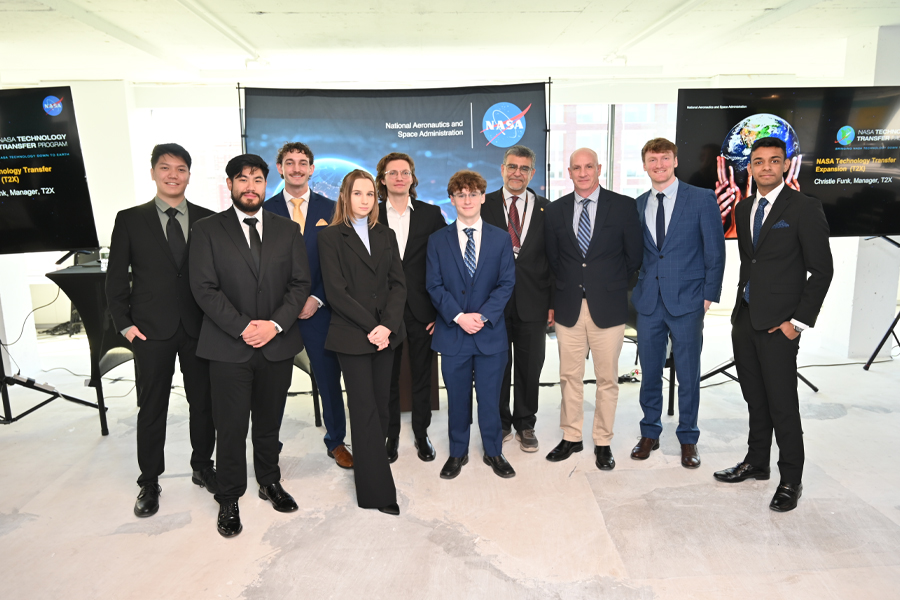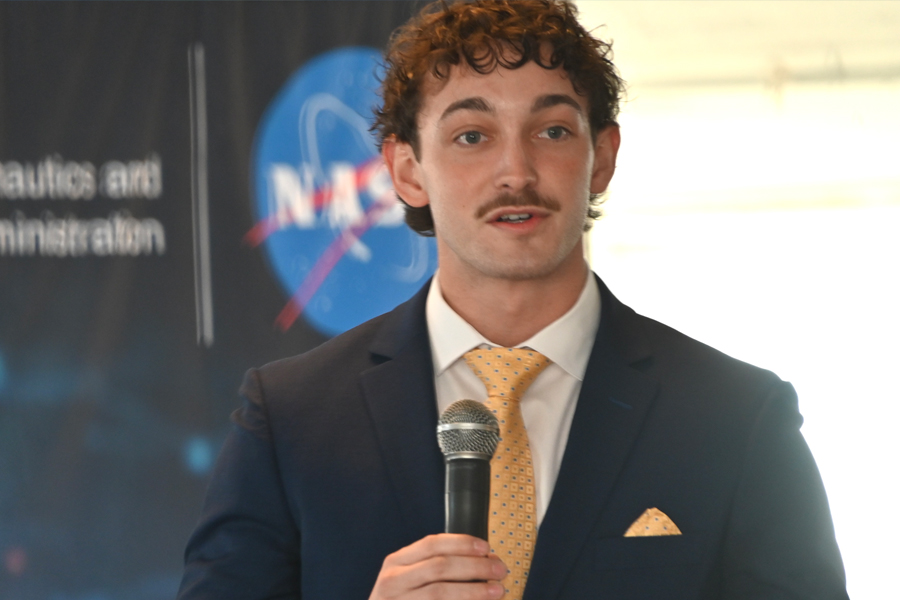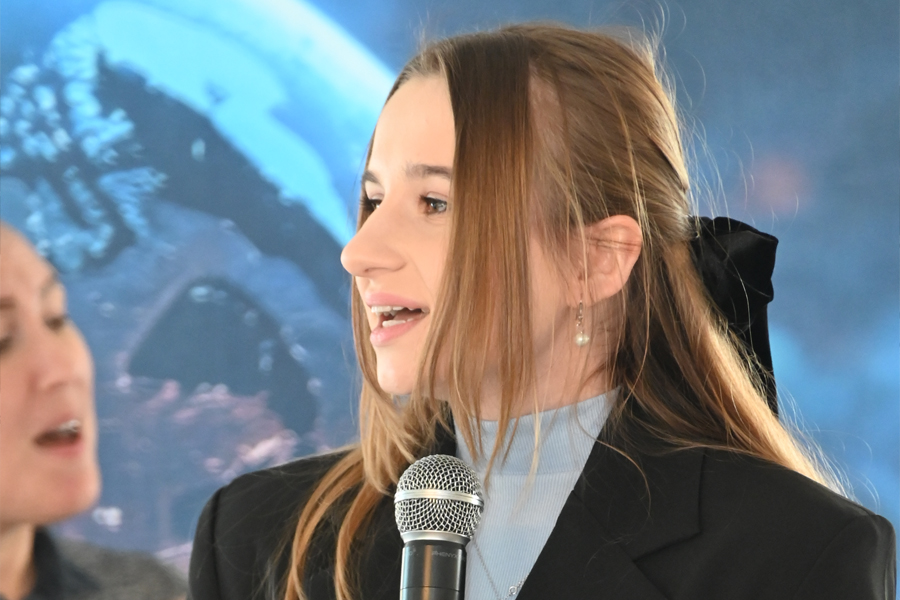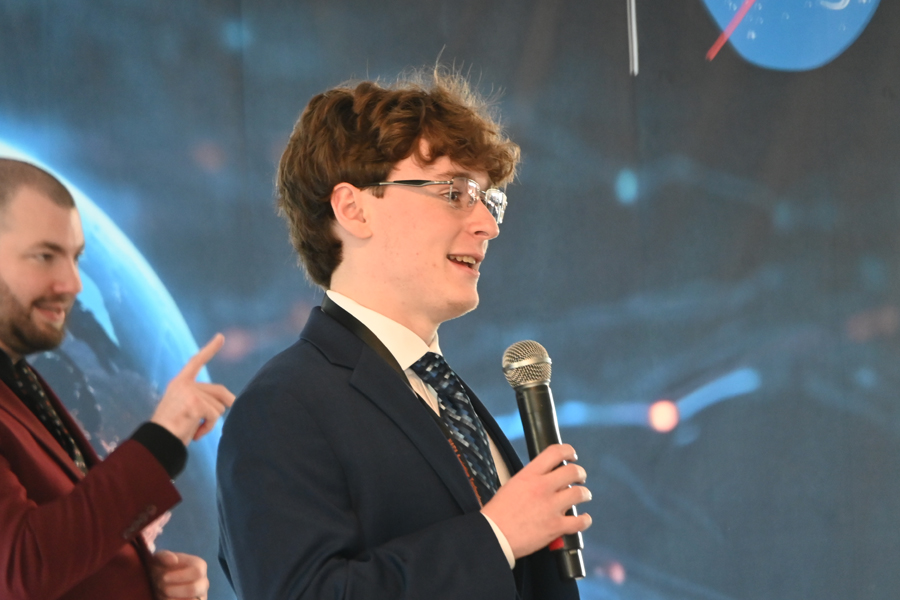The complex claims of technology patents held by NASA are what make NASA’s innovative discoveries so valuable. Engineering students at the Entrepreneurship and Technology Innovation Center at the New York Institute of Technology (ETHICS) not only decode these patents, but they also build prototypes to demonstrate their operability. And, for the first time, eight engineering students presented their work publicly to a NASA patent licensing group and about 50 entrepreneurs hoping to get their startups off the ground.

ETIC Director Michael Nizich (third from right) and Dean Babak D. Beheshti (fourth from right) with engineering students who presented their work at the NASA Assistive Technologies Startup Summit, hosted by STEMComm Ventures.
Thanks to New York Tech’s contract with NASA’s Technology Expansion (T2X) initiative, which has been ongoing since 2021Each year, ETIC engineering students produce prototypes selected on the basis of patents provided to them by NASA. Then NASA can use these prototypes to demonstrate potential uses of the patents in hopes of licensing the technologies to the business world.
In December, eight ETIC students presented seven of their prototypes at the NASA Assistive Technologies Startup Summit, hosted by STEMComm Ventures, an innovation commercialization and consulting firm that helps entrepreneurs turn intellectual property into products and real services. All seven prototypes have the potential to help people with mobility issues, sensory issues or other challenges.
“NASA contract connects academic knowledge to real-world applications,” says Babak D. Beheshti, Ph.D.dean of College of Engineering and Computer Scienceswho also attended the summit. “This partnership not only elevates our institution’s reputation globally, but also empowers our students to lead and innovate in the rapidly evolving fields of science, technology and engineering.”
“The goal of the conference was for NASA to show entrepreneurs the benefits and licensing process of a NASA patent to grow their business, and that it is affordable for them,” said the ETIC director . Michael Nizich, Ph.D. “Entrepreneurs have learned that these NASA patents are already being turned into demonstration models, and ETIC is one of the places where they can do that. »
“ETIC students have done an outstanding job showing entrepreneurs how technology can move from a patent to an actual product,” says Jeff Johnson, founder of STEMComm Ventures. “The theme of the summit was impact beyond innovation, and the students designed their presentations for people with different abilities. We couldn’t be more proud of them.
The NASA contract is a formal relationship between government and business: students have regular meetings with NASA T2X management to demonstrate their progress and discuss next steps in building the prototypes. “ETIC students are exceptional. Through this contract, students gain hands-on experience while creating deliverables that enhance our resources for potential start-up companies,” says Christie Funk, T2X Program Manager. “We are always impressed by the work they do, and it was a privilege for me to invite them to the summit. »

Brandon Castellano
Prototype presentations
Among the students who presented prototypes at the conference Brandon Castellano (BS’24)graduate in mechanical engineering and student in computer science Joanna Sroka (BS’24)holder of a bachelor’s degree in computer science.
Castellano served as project manager for PUMA, or Portable Unit for Metabolic Analysis, a device that can be used to measure a person’s oxygen and carbon dioxide levels in real time to predict the risk of hypoxia, which occurs when the body does not receive enough. oxygen.
“PUMA measures your breaths: how much oxygen you inhale and how much carbon dioxide you exhale,” Castellano explains. “If someone is in an area where oxygen levels are depleted and you notice their oxygen is low, you can move them immediately. It can save someone’s life. These seconds count and could be the difference between life and death.
The technology was originally developed for fighter jet pilots, but it has many other potential real-world applications. During his presentation at the summit, Castellano explained the functionality of the device and some potential assistive commercial applications, such as remote health monitoring. Instead of visiting a doctor, a patient with asthma or lung cancer, for example, can wear a respirator mask connected to the device at home, and the doctor can evaluate the air level data. oxygen to the patient and provide the necessary treatment.
“As soon as you breathe in and out, your doctor can see the quality and quantity of the air you breathe,” says Castellano, noting that startups could use the device in other ways to meet their business needs, and this at a lower cost. .
We are an affordable laboratory because of the intricate craft work done by students within a limited budget,” says Sroka, who presented ZONE (Zeroing Out Negative Effects), a negative reinforcement biofeedback training technology originally developed for the psychophysiology of sport (mind and body). applications. For the NASA prototype and consistent with all claims in the patent, Sroka illustrated the technology for potential applications in assisting people with mobility issues. For example, she says, ZONE could be used as an occupational therapy tool for people with developmental or neurodegenerative disorders, or as a rehabilitation tool to help someone after a head injury.

Joanna Sroka
Improve their game
Although ETIC students have been building prototypes for NASA for four years, their delivery system has grown and evolved into a robust, commercial-grade deliverable.
ETIC students now deliver their prototypes in a “smart case”, designed by a mechanical engineering student Tyler Hradek. Standardized electronic components are integrated directly into the 3D printed housing, alongside a storage area for the prototype. So instead of needing external electronics, such as a monitor and mouse, NASA can power the smart box and immediately demonstrate the prototype.
“We use the smart box to physically deliver and display the NASA prototypes,” says Nizich. “Much like a computer in a shipping container, the smart box can be used to control and run software for various prototypes. Although born out of necessity, the smart box is now a viable product in its own right.
NASA likes the simplicity of demonstrating the prototypes using the smart box. “The prototype is easy to transport and demonstrate because everything is inside the smart box,” says Funk. “It’s a creative way to demonstrate the prototypes and allows us to generate interest in NASA technologies.”
Share knowledge
Because the Smart Case is not a NASA patent (the intellectual property is owned by New York Tech), ETIC launched a pilot program to partner with local high schools to provide experiential learning experiences in STEM fields (science, technology, engineering and mathematics). students. Through its current partnership with John F. Kennedy High School in Bellmore, New York, ETIC provides all materials in kit form, including electrical components, 3D printed parts and assembly videos. Then, high school students can gain experience assembling the smart box, meeting regularly with Hradek to discuss challenges and show their progress.
“If students have questions, they can ask me,” says Hradek. “I help them think about engineering and solve problems, giving them ah-ha moments.”
The benefits of the partnership are two-fold: high school students gain valuable hands-on experience working with technology and learning from college engineers, and the university benefits from providing its own students with teaching experience , consulting and project management with geographically disparate teams. .
“To build the smart box in our lab, it only takes four hours with our engineering students,” says Nizich. “But this project, although more expensive for us, allows us to establish a relationship with the high school: we teach them and provide them with real-world experience, and in return, they work with university engineers who are just a few of them. some. years older than them.

Tyler Hradek
Interdisciplinary teamwork
In addition to supervising high school students, ETIC students also help each other. It takes an interdisciplinary team of mechanical engineers, electrical engineers, computer scientists and other specialists to create each prototype. Although there is only one project manager for each NASA patent, many students have hands on the prototype, so each must keep the others in mind when designing their portion.
“It’s not difficult to do your part, but making sure other people can do it their some of it is difficult,” says Hradek, who presented the RoboGlove, a work in progress that can help people with limited mobility, at the Assistive Technology Summit. “For example, I have to install the wiring on the RoboGlove, but I don’t do the construction. So I have to talk to programmers and computer science students and ask them, “Can you do your job if I do mine this way?” »
Sroka created the circuit design for ZONE, but she said she couldn’t have completed the project without the help of ETIC engineers. “We’ve used eight versions of ZONE, so now engineers are running away from me because they think I might ask for another version,” she says with a laugh. “But we want to be proud of our work, so we keep testing to make sure it’s absolutely perfect.”
Impact the future
Castellano says joining ETIC as a sophomore completely changed his outlook on engineering and his life goals, especially after developing NASA technology.
“I use patents that are already available and then realize the impact that the technology I am developing has the ability to save lives and make a difference in the world. I really want to do that in the future,” Castellano said. “I show prospective engineering students around ETIC and talk to them about the impact we have. The excitement of working in the lab every day is priceless.
By Ashley Festa


